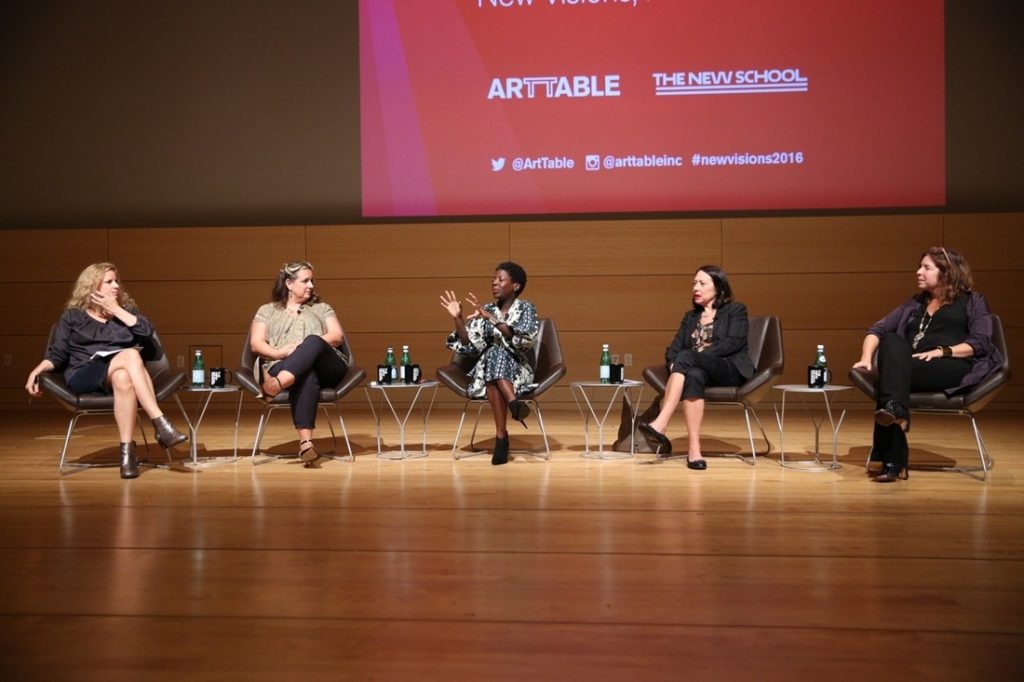In my previous post, I explored the idea of gendering the museum space, interrogating as to how museum spaces function as nurturing, comfortable places for women to visit, where they can access stimulating ideas, and connect with like-minded individuals. I was viewing the museum space from the perspective of women visitors, seeing as to how they engaged and interacted with it.
What happens when you shift the gaze from women accessing the museums to them assuming leadership there? Why is it so vital that museums have woman directors and what do they bring on board with their arrival?
The world’s first bookstore dedicated to women released a t-shirt in the 1970s featuring the slogan, “The future is female.” The art world in turn has appropriated this iconic statement to challenge the marginalization of women in both museum collections and leadership. If the future truly will be female in the art world especially vis a vis the latter, women directors are the most effective agents of change, wielding the opportunity to introduce parity in gender programming as well as encourage increased representation of women artists, challenging the dominant pre-existing narrative of a long entrenched and primarily male historical canon.

How to Create Gender Equality in the Arts, According to Four Female Museum Directors photo credit – Lucea Spinelli
Are women leaders in the museum world being given those responsibilities though? And even if they are, is the gesture enough? What I would like to specifically draw attention to is difference between gender equality and equity in this context and how museums today can encourage, support, and implement that difference. While equality focuses on each defined gender group having access to the same share of field, equity meanwhile focuses on when each group gets what they need to be successful in the field.
If we first look at gender equality in the museums, gender mainstreaming in the global museum space has undoubtedly undergone much transformation in the recent years. According to a report released by the Mellon Foundation, the Association of Art Museum Directors, and the American Alliance of Museums,60% of the museum staff in museums across the United States is now women; however, this sizeable growth begs the question as to whether it correlates with the transition of museums from being bastions of cultural authority to those spaces encouraging community engagement and informal learning, qualities generally associated with women. Are museums essentially mirroring and reiterating male-female power hierarchies and structures seen elsewhere in society?
The director and president of Minneapolis Institute of Art (MIA), Kaywin Feldman also notes that “as soon as the professionals became mostly female, they become less respected and poorly paid.” And indeed, the female director’s salary still lags behind that of her male counterpart, adding to the list of the other discriminations that women have to face across the museum space.
Museums with more limited budgets are more likely to have women directors; however, museums which are more well endowed, have long, prestigious histories, and central locations have always favored male directors. For example, in 2015, only men occupied the leadership positions in the world’s top twelve art museums (museums whose budgets exceed $20 million dollars). Only five of the prominent American art museums’ directors were women. No woman has ever assumed leadership of the top three international museums: Louvre, British, and the Metropolitan. It’s also telling that 75% of women museum professionals are much more likely to be found in curatorial positions. What the situation reveals that it is not as much that women are unqualified to take the responsibilities as about the ubiquitous glass ceiling that they have to shatter.
In the Indian art scene, interestingly enough, in contrast, the future is already female though. In 2014, Securities and Exchange Board of India (SEBI) had asked companies listed on the Indian stock markets to have at least one woman on their board of directors. Ever since this requirement became mandatory there has been a steady increase of women in leadership roles not just in the corporate sector but has its effect in the other sector as well. More women dominate and indeed, shape the art scene than men, whether in capacity of curators, collectors, or directors, unlike their Western counterparts. Kiran Nadar is the chairperson of the Kiran Nadar Museum of Art, Delhi, having founded the museum to encourage a more rich museum-going culture in India amongst other goals. Lekha Poddar co-founded Devi Art Foundation, nurturing a progressive curatorial vision while Dr Tasneem Zakaria Mehta has been widely credited with transforming and reinvigorating Mumbai’s oldest museum, Bhau Dadji Lad Museum since her appointment in 2008.
One of the other reasons attributed to women’s rise in the art world in India and the region has nonetheless been the perception of art being a woman’s domain, thus enabling them to penetrate and own a space which was not considered traditionally masculine. The fact that many of the women are privileged has also been considered a factor, flagrantly obscuring their work ethics, dedication, and vision. Whatever may be the reasons, it is undeniable that their presence at the helm of museums is crucial towards creating spaces for debate, taking risks in displaying what they do, and sowing the seeds of social change.
The director of The Metropolitan Museum of Art recently resigned and a commentator, Liza Oliver observed in an opinion piece that it was perhaps an apt time to start thinking about the museum hiring a woman director for the first time ever. It is clear that geography is influencing as to where the future needs to become or is already more female.
Nevertheless, until debates such as those concerning the appointment of and suitability of women as museum leaders or women being shackled by the stereotypical associations between gender and culture do not become redundant, much more dialogue regarding equality and equity regarding women and museum leaders requires to happen. The gender parity that will ideally happen as a byproduct of these discussions will subsequently pave the way for diversity in all aspects of the museum programming. Only then can museums be considered an equal playing field indeed.
 Priyanka Sacheti is an independent writer. She has been published in numerous publications with a special focus on art, gender, diaspora, and identity. She’s author of three poetry volumes and currently working on a collection of short stories. She currently consults at ReReeti and is an editor at Mashallah News. An avid amateur photographer, she explores the intersection of her writing and photography at her blog, http://iamjustavisualper
Priyanka Sacheti is an independent writer. She has been published in numerous publications with a special focus on art, gender, diaspora, and identity. She’s author of three poetry volumes and currently working on a collection of short stories. She currently consults at ReReeti and is an editor at Mashallah News. An avid amateur photographer, she explores the intersection of her writing and photography at her blog, http://iamjustavisualper
ReReeti works with museums, galleries and heritage sites across India to plan strategies, design systems and implement programmes to increase audience engagement and institutional visibility. Email us at info@rereeti.org for a free consultation or to collaborate on an upcoming travelling exhibition.










Recent Comments